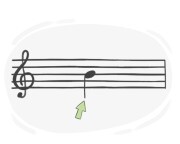Muzyka - Notacja muzyczna
Tutaj nauczysz się niektórych angielskich słów związanych z notacją muzyczną, takich jak "krzyżyk", "fermata" i "glissando".
Przegląd
Fiszki
Pisownia
Test


cała nuta
Gdy dyrygent dał sygnał, smyczki zagrały całą nutę, stanowiąc podstawę dla melodii instrumentów dętych drewnianych.

tonacja
Gitarzysta zaimprowizował solo w tonacji Es-dur, pokazując swoją wszechstronność i umiejętności.

środkowe C
W nutach, środkowe C jest wskazywane przez linię pomocniczą poniżej pięciolinii w kluczu wiolinowym lub powyżej pięciolinii w kluczu basowym.

kasownik
Skrzypek dostroił intonację, dodając kasownik, aby poprawić znak przygodny.

oktawa
Harmonie chóru były bogate, z głosami mieszającymi się w różnych oktawach.

akord
Głos piosenkarza idealnie harmonizował się z akordem pianina.

krzyżyk
Dyrygent przypomniał orkiestrze, aby zwracała uwagę na krzyżyk w muzyce, aby zagrać właściwą wysokość dźwięku.

półnuta
Dyrygent polecił muzykom, aby podkreślali półnutę na początku każdego taktu.

ćwierćnuta
Linia basowa zapewniła solidną podstawę, akcentując ćwierćnuty na każdej mocnej części taktu.

tonika
Jako dyrygent podkreślił znaczenie toniki w ustalaniu centrum tonalnego muzyki.

kreska taktowa
Każdy takt w nutach jest podzielony kreską taktową.

klucz
Piosenkarz miał trudności z identyfikacją znaku przykluczowego wskazanego przez klucz, co spowodowało zamieszanie podczas próby.

tabulatura
Basista polegał na tabulaturze, aby nauczyć się linii basowej nowej piosenki.

ósemka
Basista dodał synkopowane ósemki do groove'u, wzmacniając rytmiczne uczucie piosenki.

szesnastka
Gdy tempo rosło, pianista wykonał grad szesnastek z zwinnością i kontrolą.

trzydziesta druga nuta
Dyrygent podkreślił precyzję i klarowność każdej trzydziestodwójkowej nuty w wykonaniu zespołu.

sześćdziesięcioczwórka
Wykonała serię sześćdziesięcioczwartych nut z jasnością i kontrolą, zapewniając, że każda nuta była wyraźnie artykułowana.

wspólny czas
Utwór płynnie przechodził między różnymi metrumi, naprzemiennie stosując wspólny czas i złożone oznaczenia metrum.

łuk
Jako wokalistka, śledziła legato w nutach, aby kształtować frazy i przekazywać emocje.

ćwierćton
Występ piosenkarza zawierał ekspresyjne wokalne slajdy wykorzystujące ćwierćtony do wywołania emocji.

znak przygodny
Znak przygodny sprawił, że melodia brzmiała bardziej dramatycznie i niespodziewanie.

arpeggio
Delikatne arpeggia harfistki stworzyły spokojną i eteryczną atmosferę podczas utworu orkiestrowego.

tryl
Ćwiczyła tryl na trąbce, skupiając się na osiągnięciu równomierności i klarowności w szybkich oscylacjach.

wartość nuty
Tempo piosenki określa, jak szybko lub wolno są grane wartości nut, wpływając na ogólne wrażenie i energię muzyki.












































